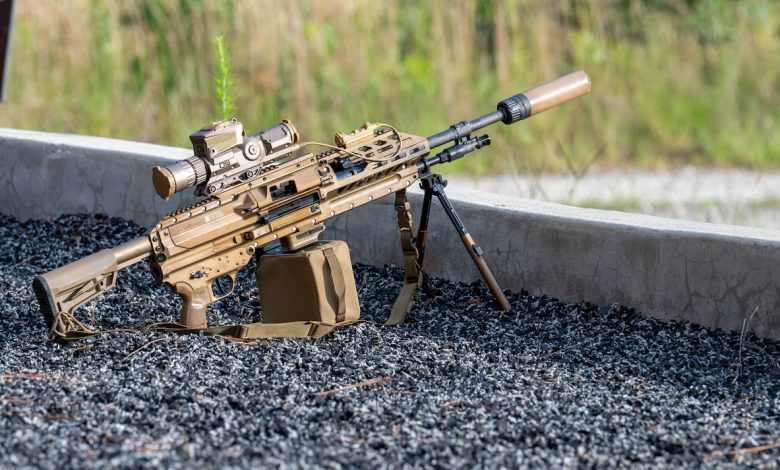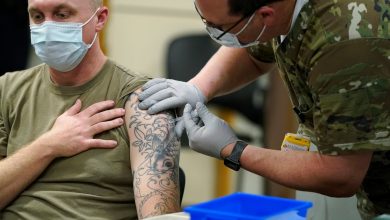Sensor upgrades next up for the Army’s new rifle and machine gun

The next developments for the Army’s newest rifle and machine gun may have more to do with software than bullets.
The Army fielded its first batch of the Next Generation Squad Weapon, or NGSW, system to soldiers from the 101st Airborne Division earlier this year. Meanwhile, officials overseeing the program recently announced the next dozen units to receive the weapons systems over the coming year, with many of the personnel expected to field the new equipment assigned to Pacific-focused units.
For most of those units, that new arsenal will include the rifle, automatic rifle and the fire control, or weapon’s optic. But beyond the changes to firearms themselves, it’s the fire control, known as the XM157, that’s likely to see the most substantial development in the coming years.
RELATED
The high-tech optic is more than just a simple rifle scope. It contains a ballistics calculator and a built-in range-finding module that help shooters determine their aiming point and adjust their fire as they go.
It also includes an atmospheric sensor, compass and both visible and infrared aiming lasers.
For any personnel other than snipers or special operators, the elaborate optic system has been unavailable until now. And even those troops who have received it have often had to combine multiple devices to access some of those features when shooting.
The fire control also features wireless connectivity, allowing users to potentially work with the Integrated Visual Augmentation System, or IVAS, a helmet-mounted situational awareness and night vision device that’s currently under development as part of a joint venture between the Army and Microsoft.
Weapons developers, however, are looking to the defense industry for more.
“We’re trying to create a market space for sensor development to ‘plug and play’ on top of that,” said Col. Jason Bohannon, head of Program Executive Officer-Soldier Lethality.
Bohannon added that the Army plans to unveil more details of what the service is potentially looking for at upcoming industry events.

The new weapons, meanwhile, pack the punch of an all-new caliber — the Army-designed 6.8mm — which extends the range and power of the individual rifle, the XM7, and automatic rifle, the XM250.
For units receiving them, the XM7 and XM250 are the replacements for the older M4 carbine and M249 Squad Automatic Weapon, respectively, which both chambered 5.56mm ammunition.
The weapons are being fielded first by personnel assigned to close combat units, such as infantry, combat engineers and special operations troops. The rest of the Army will continue to be outfitted with the M4 and M249 for the foreseeable future.
The tech of the fire control is vital in order to take full advantage of the added range and barrier-busting abilities of a round that matches or exceeds the performance of a heavier caliber, the 7.62mm, which is the M240 machine gun’s round size for platoon-level fires, experts said.
To help meet those expectations, the Army in 2022 chose firearms manufacturer Sig Sauer to produce the NGSW and at least some of the new 6.8mm ammo. The initial contract that was awarded featured a 10-year, $20.4 million agreement for the company to produce the first batch of rifles, Army Times previously reported.
The fire control contract, which was also awarded in 2022, went to the Vortex Optics subsidiary Sheltered Wings. The maximum quantity under that contract was set at 250,000 fire control optics systems, which came with a price tag of $2.7 billion, Army Times previously reported.
On the weapon’s side of development, soldiers at Fort Campbell, Kentucky, in October are conducting a user assessment of the systems, Lt. Col. Trond Ruud, PEO Soldier product manager for the Next Generation Squad Weapon and fire control optic, told Army Times.
In 2025, Army personnel are expected to conduct testing on the weapon’s system and fire control in hot weather and tropic settings, Ruud added.
The following units are slated to the receive the weapon next, with rollout of the systems scheduled between October and September 2025, Army Times previously reported:
- Army Reserve’s 100th Infantry Battalion, 442nd Infantry Regiment at Fort Shafter, Hawaii
- Elements of the 25th Infantry Division, at Schofield Barracks, Hawaii
- Army Ordnance School, at Fort Gregg-Adams, Virginia
- 3rd Brigade, 101st Airborne Division at Fort Campbell, Kentucky
- 2nd Battalion, 75th Ranger Regiment at Joint Base Lewis-McChord, Washington
- 1st Brigade, 1st Armored Division, at Fort Bliss, Texas
- 1st Battalion, 75th Ranger Regiment at Hunter Army Airfield, Savannah, Georgia
- 1st Brigade, 34th Infantry Division, with the Minnesota Army National Guard
- Multiple 10th Mountain Division battalions, Fort Drum, New York
As the weapons and optics are gradually distributed across the force, Sig Sauer will be busy producing the new 6.8mm round at its facility in Arkansas. The Army is also adding a dedicated line of 6.8mm production at its Lake City Army Ammunition Plant in Independence, Missouri, Bohannon noted.
The 6.8mm munition will be made the standard ball ammunition round, which is the common round used in combat.
Additionally, Joint Program Executive Officer Armaments and Ammunition is now working on a reduced-range 6.8mm round, said Col. Steven Power, program manager for maneuver ammunition systems at JPEO armaments.
The reduced-range round will allow soldiers to test fire the Next Generation Squad Weapon on already established ranges that were designed for 5.56mm weapons systems.
Todd South has written about crime, courts, government and the military for multiple publications since 2004 and was named a 2014 Pulitzer finalist for a co-written project on witness intimidation. Todd is a Marine veteran of the Iraq War.







